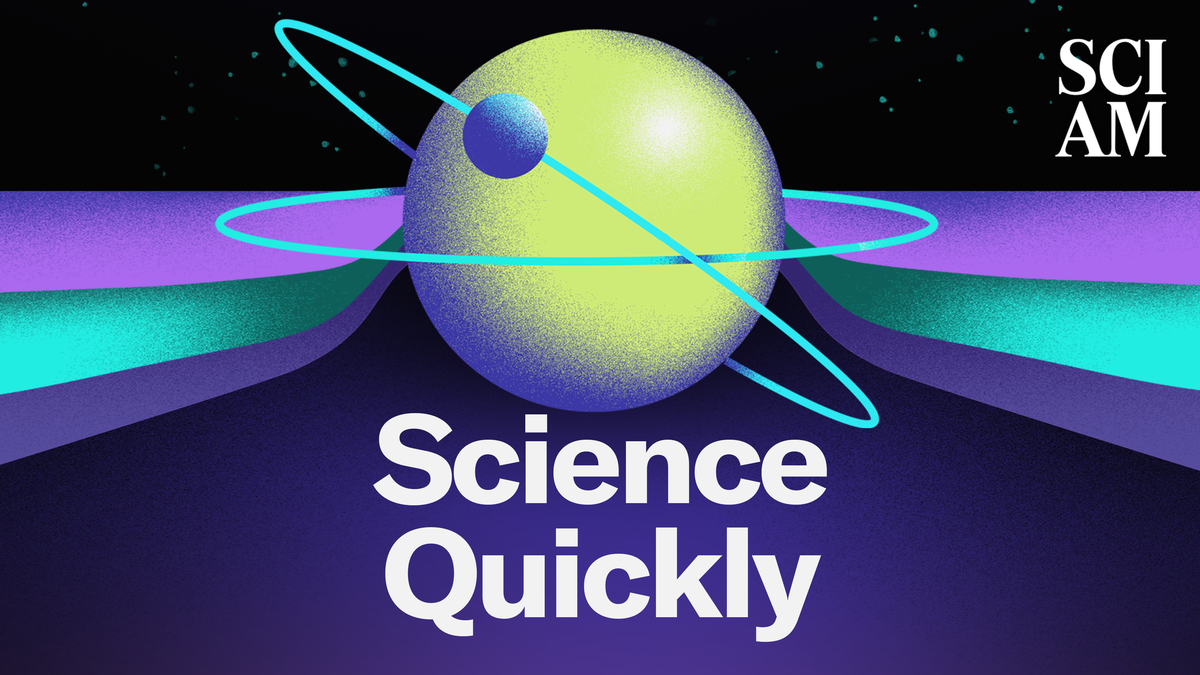Rachel Feltman: Completely satisfied Monday, listeners! For Scientific American’s Science Rapidly, that is Rachel Feltman.
First, I simply wish to say that I imagine radical optimism goes to be an vital a part of our device equipment within the months to come back. So I’m going to do my greatest to carry you tales that present how innovation will help change the world for the higher. We’re going to maintain introducing you to sensible people who find themselves working to unravel issues that appear insurmountable. We’re going to maintain taking you to locations you’ve by no means been to be taught issues that broaden your horizons and give you new methods of seeing the world. We’re additionally going to attempt to offer you pleasure and levity and that indescribable “wow, gee whiz” feeling as usually as we will as a result of we all know that’s so vital.
Okay. So. Let’s kick off the week by catching up on a number of the newest science information.
On supporting science journalism
When you’re having fun with this text, take into account supporting our award-winning journalism by subscribing. By buying a subscription you’re serving to to make sure the way forward for impactful tales concerning the discoveries and concepts shaping our world in the present day.
The world’s first wooden satellite arrived on the Worldwide Area Station final Tuesday. The Japanese spacecraft is simply 4 inches sq.. As I’ve talked about earlier than on Science Rapidly, the rapidly growing number of metal satellites in orbit pose an actual risk to our planet’s ozone layer. That’s as a result of spacecraft made principally of aluminum produce hazardous aluminum oxide once they dissipate within the environment, which is an inevitable a part of their life cycle. I’ll spare you the inorganic chemistry, however these aluminum oxide particles can kick off reactions between ozone and chlorine within the Earth’s environment. LignoSat incorporates digital sensors, however its physique is manufactured from magnolia wooden. Researchers hope to deploy the cubesat from the ISS and accumulate information because it orbits the planet for a number of months.
Talking of house: last Wednesday NASA’s Parker Solar Probe took an important step towards making a record-breaking move of the solar. On December 24 the probe is predicted to move inside 3.86 million miles of the photo voltaic floor—breaking its personal 2023 report of 4.51 million miles.
Parker has been breaking information since its launch in 2018. That yr the probe handed inside 26.55 million miles of the solar’s floor, surpassing a report set within the Seventies.
Final Wednesday the probe flew by Venus to make use of the planet’s gravity to propel it into its new orbit. NASA says the December photo voltaic move will carry the spacecraft “shut sufficient to move inside a photo voltaic eruption, like a surfer diving underneath a crashing ocean wave.”
Again on Earth issues are wanting fairly dry. The U.S. Drought Monitor reports that nearly every state in the country is experiencing drought—Alaska and Kentucky are the one exceptions. From October 23 by means of 29 greater than 150 million folks across the U.S. have been in a drought, which marked a roughly 34 p.c improve over the week earlier than.
Local weather change is contributing to drought in additional methods than you may assume. Whereas some areas are seeing much less rain on the whole—which after all creates arid circumstances—others are getting most or all of their rain abruptly.
There’s a restrict to how a lot water soil can take in, so an extreme dump doesn’t essentially go away behind additional moisture for us to depend on throughout not-so-rainy days. As an alternative that water turns into what we name runoff, which flows throughout the bottom till it enters a stream or one other physique of water.
Local weather change appears to be making these massive bursts of precipitation extra frequent. So when it rains, it pours, and it floods, and we’re nonetheless liable to finish up in a drought down the road. With such vast swaths of the nation in drought proper now, it’s not a nasty concept to take water-conserving measures irrespective of how issues look the place you reside. Contemplate taking shorter showers, and be sure to flip off the tap when you brush your tooth and scrub dishes.
Talking of water, here’s a news story to get you fired up about one in all my favourite issues to hate: plastics! When you’re simply becoming a member of us (on Science Rapidly and likewise, like, on Earth), most plastics are actually manufactured from fossil fuels, and so they’ve proven up just about in all places, from Antarctica to the human mind.
Final Wednesday a brand new examine discovered that microplastics may even be mucking up our skill to wash wastewater for reuse. The researchers suspected that tiny plastic particles referred to as microplastics, which offer a cheerful residence for microbes to create strong colonies referred to as biofilms, may hold potential pathogens alive by means of the wastewater remedy course of. Positive sufficient, the researchers recognized a number of nasty sorts of micro organism and viruses that endured after the water was handled. This is only one extra piece of proof in a rising pile that reveals we want to deal with our reliance on plastic.
Let’s finish with a few enjoyable tales.
First: you understand how generally, when somebody is watching you’re employed, it makes you sort of, like, knuckle down and actually get the factor finished, and generally having an viewers could make you choke as a substitute? Apparently these instincts are older than our species.
In a study published last Friday, researchers reported that chimpanzees are topic to what’s referred to as the “viewers impact,” too. The examine reviewed years of information on chimps performing number-based duties on contact screens. It seems that the chimps’ efficiency was impacted by what number of people have been watching and whether or not the animals knew the spectators. When it got here to the hardest numerical duties, the chimps appeared to carry out higher as an viewers of experimenters grew. However they have been extra more likely to fumble the best duties within the presence of a crowd of experimenters and acquainted viewers members. The researchers are hoping to make use of these insights to higher perceive how people developed related conduct.
Lastly, right here’s one for you sports activities followers. As you could already know, each single baseball utilized in each single main league sport will get a particular little spa remedy: it’s scrubbed down with mud that comes from a single secret spot somewhere along a tributary of the Delaware River. The concept is that this mud tub makes the balls simpler to grip. No staff is prepared to fiddle with substitutes, however the je ne sais quoi of this specific goop was solely lately subjected to scientific examine. In a paper published last Monday, researchers confirmed that the mud actually does have a sure one thing going for it.
The analysis staff put a number of the magic mud in a precision instrument referred to as a rheometer, which applies totally different sorts of drive to determine the fluid flows, to quantify the spreadability of the substance. The researchers additionally used an atomic drive microscope to measure how a lot drive the mud resisted with as an instrument pulled away from it—in different phrases, its stickiness. They even made a pretend human finger out of rubber—which they coated with whale oil to imitate the pure goop of human pores and skin—to approximate the friction of a ball in opposition to a pitchers’ fingers.
All that information proves what baseball gamers have been saying for years: the mud works. Its consistency makes it as simple to unfold as face cream, which permits for uniform protection on a ball. However the stickiness of the clay helps all of the tiny particles of sand suspended inside it adhere to the ball so the muck dries as grippy as sandpaper. Neat!
That’s all for this week’s science information roundup. We’ll be again on Wednesday to find out how bugs have helped form human tradition.
Science Rapidly is produced by me, Rachel Feltman, together with Fonda Mwangi, Kelso Harper, Madison Goldberg and Jeff DelViscio. This episode was edited by Anaissa Ruiz Tejada. Shayna Posses and Aaron Shattuck fact-check our present. Our theme music was composed by Dominic Smith. Subscribe to Scientific American for extra up-to-date and in-depth science information.
For Scientific American, that is Rachel Feltman. Have a terrific week!























































